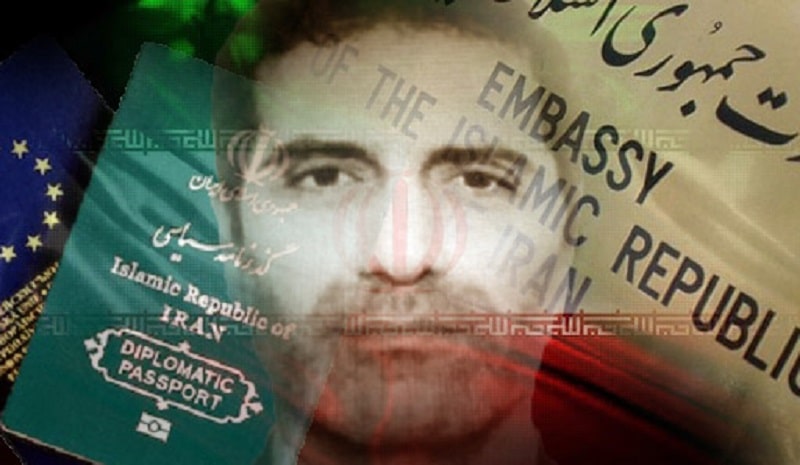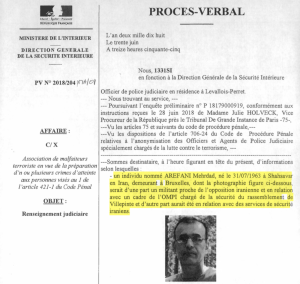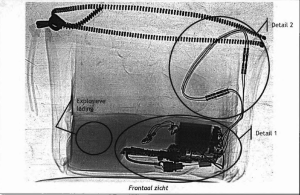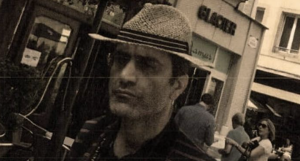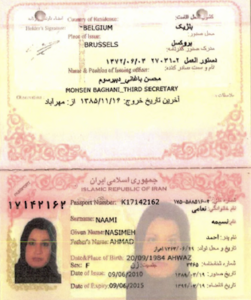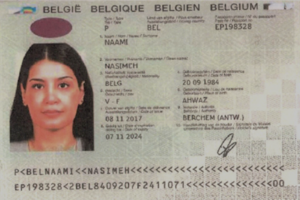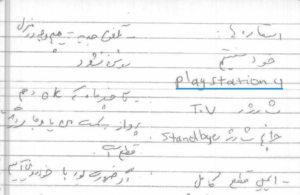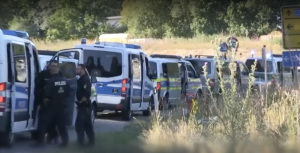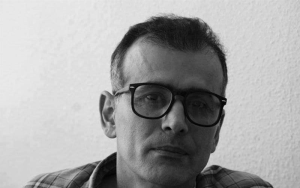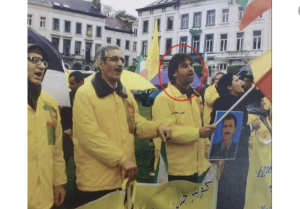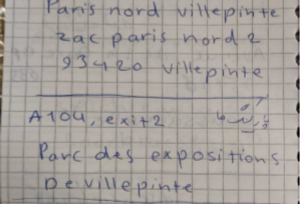Published today in the news service Iran Wire, Kambiz Ghafoori’s investigative report is translated and presented here for the first time to shed light on the illegal and murderous activities of the Islamic Republic of Iran in Europe.
—
In the hot July of 2018, in a Peugeot 308 car with license plate number VJU061, a “poet” named Mehrdad Arefani was traveling from Brussels to Paris. He had two cell phones in his pocket. One that ended in the number 2614 and his friends knew about it; another with the last four numbers 1791, of which only a few were aware. In addition to the two Belgian telephone numbers, an Austrian SIM card was waiting for him at home. At the same time, a “diplomat” of the Islamic Republic’s embassy in Austria was heading to the German border to go to Luxembourg.
The point of connection between the poet and the diplomat in this story is the bomb; a small but deadly explosive device that a couple named Nasimeh Naami and Amir Saadouni were carrying from Luxembourg which was supposed to explode with the help of Mehrdad Arefani at a major conference organize by Mojahedin Khalq, the People’s Mojahedin, an Iranian terror-opposition group.
Mehrdad was known to many in the Mojahedin organization. His commute to the conference hall was easy, and few would question his role in an impending explosion. But French security officials did not agree with the information they had already received.
Permission to prosecute Mehrdad Arefani in France
When Mehrdad Arefani arrived in Paris, a court order was already issued for his surveillance and telephone calls. We return to the “poet”.
Assadollah Asadi; operational diplomat
“We could not believe it!”, said a European official in a conversation with me about Assadollah Asadi’s case. “We did not even think of him being able to carry the bomb on a passenger plane,” he continued. The joint Austrian, Belgian, French and German security police files were based on information provided by Mossad. They knew that Assadullah Asadi was going to deliver an explosive device to several agents in Europe, but they did not know how the bomb would reach Asadi himself.
“Austrian security services have been closely monitoring Asadi,” the European official said. In May 2018, he suddenly made several flights to Tehran. The Austrian Counter-Terrorism Service (BVT) had a sharp ear. They had received information that Asadi wanted to carry a package of bombs in his handbag when he returned from Tehran to Vienna in June 2018 on an Austrian Airlines flight.”
Assadollah Asadi
Normally, the contents of a diplomat’s bag are not inspected. However, the Austrian counter-terrorism service activated code 43 on the computer of the border control department so that even when the sensors of the advanced explosive devices detected the bomb when Assadollah Asadi passed through the gates, the agents did not disturb him. The aim was to arrest Asadi later with constant pursuit and surveillance while delivering the bomb to the perpetrators. But what the Belgian Security Service (VSSE) achieved a few days later was beyond expectation: according to them, an “Alibaba Cave, full of intelligence and security treasures.”
Red Cave of Alibaba
Alibaba Cave was a red Ford SX-Max. Assadollah Asadi rented the Ford car three months before the operation to go on “vacation” with his wife and children.
Asadi rented a car after his arrest
One year before his arrest, Asadi left Austria in another rental car and spent three days in Paris evaluating how the Mojahedin event was being held. For this trip, a cleric close to Ali Khamenei, hired by a cleric named Mohammad Reza Zairi, was hired to track the missing car.

One of the cars that Assadollah Asadi rented was registered with the license of Mohammad Reza Zairi (the cleric on the right in this photo).
In response to my question, Zairi called the news a “dirty game” and wrote on Twitter: “The whole point is [that] I was on a trip to Europe and I wanted to rent a car. Because I could not legally take it myself, the children of the embassy rented it for me and I owned the car for a while and then I handed it over. this.”
In any case, the red Ford had a passenger that did not resemble the “provincial collar” officials of the State Department. Straw hats, short-sleeved clothes and shaved beards are not how diplomats of the Islamic Republic usually dress even during the holidays.
An x-ray image of the Bomb provided by the Begian police.
An advanced bomb containing half a kilogram of triestone trioxide (TATP) explosives, along with a separate detonator and remote control, was in the trunk of the car, but neither Asadi’s wife nor, of course, his children were aware of this.
The red Ford car crossed the German border at dawn on the Austrian highway A8 and entered the German highway No. 3. In Germany, he stopped several times in the parking lots of chain stores such as Liddell, without buying. Surveillance of Asadi on hundreds of kilometers of road required a large team of security agents. On top-secret missions, the main effort is to keep the circle of operations aware as small as possible so that it is less likely to be exposed. “In the 21st century, you do not need to fill the streets with agents,” he said, when asked by a European source, without elaborating. “The idea of an officer sitting on a bench in a raincoat and hat with a newspaper in front of him is related to the stories of the last century.”
I believe that in the pursuit of Asadi and his companions, in addition to cars equipped with locating technology and traffic cameras, satellites of security services have been used. The European sources I spoke with declined to confirm or deny this.
The Asadi family spent some time in Germany. He then made his way to the Luxembourg border and entered the small country via the A1 motorway. Asadi was in contact with him on July 25, 2018 to deliver the bomb to them.
The location was 13th Place d’Armes, a branch of Pizza Hut chain restaurant. The bomb was carefully placed in a cosmetic bag. The bomb’s very small remote control was also included in a box of tampons to make it easier to pass through normal inspections.
Before meeting the two bombers, Asadi visited several stores in Luxembourg. Normally, anyone who saw Asadi with a camera hanging around his neck would think he was an ordinary tourist; Except for those who followed him. Asadi “goes against the chase” to find out if anyone is looking for him. Unaware that he was not only being pursued but also security agents were recording his journey moment by moment with photos and videos.
At the “accidental” checkpoint in Luxembourg, when asked for identification, he introduced himself as a diplomat who had traveled with his family on “vacation”. He opened the trunk of the car with an open face, passed his documents to the police and continued on his way. The same “holiday” claim was later documented in his rejection of his request for diplomatic immunity.
The moment Asadi sat in front of Nasima and Amir at Pizza Hut to hand them the bag containing the bomb, he was relieved that no one was following him. He gave a mobile phone with an Austrian SIM card to Nasima and Amir, explained the correspondence codes and made the final orders. Asadi wrote down many notes in a notebook. We will deal with these mysterious booklets later.
Nasima Naami, a different spy
Nasima Naami emigrated to Europe more than a decade ago as a political refugee. But she was not like other refugees. As soon as he was granted asylum, his travel to Iran began with an Islamic Republic passport from Turkey.
In 2004, he met Amir Saadouni via the Internet. They got married in absentia a year later, and three years later, Nasima arrived in the Netherlands with a fake passport; Saadouni took him to Belgium and registered his asylum application. Immediately after arriving in Belgium, Nasimeh worked on Amir to prepare him for cooperation with the security forces of the Islamic Republic.
Before becoming a Belgian citizen, Nasimeh traveled to Turkey with a refugee travel permit and from there traveled to Tehran with an Iranian passport issued by the Embassy of the Islamic Republic in Brussels.
After gaining Belgian citizenship, Saadouni made little effort to keep his travels secret. His Iranian passport records show that he traveled to Iran several times between 2010 and 2018. These trips, however, were not limited to visiting friends and family.
Amir Saadouni has declared that their cooperation with the Ministry of Intelligence began in 2007, but there is evidence that Nasima’s activities were more extensive than her husband knew. It is highly suspected that the process of online dating was a trap for hiring Amir Saadouni from the beginning. Nasimeh was a person above Amir in the assassination organization.
On some trips to Iran, Nasimeh took her husband with her. They visited their families in Ahvaz and Abadan, but according to Amir in his confession, an important part of their travels was spent meeting with intelligence agents. Initially, the Khuzestan Intelligence Agency was responsible for the contacts. The rank gradually rose and Assadollah Asadi got in touch personally. When they were in Tehran, their accommodation was the Esteghlal Hotel in Tehran.
In an interview with Belgian security officials, Amir Saadouni narrated details of his meeting with Asadi at the Esteghlal Hotel. Later, the cooperation of Amir with the Belgian court caused his prison sentence to be issued with a slight reduction. In the following, we will discuss the reasons for this cooperation.
Prior to meeting Nasimeh, Amir Saadouni himself had participated in several Mojahedin demonstrations under the cover of a fan, following several rejections of his political asylum application, and had taken photos with some of the organization’s figures in order to use these photos in his refugee application. He finally agreed to apply for a residence permit in Belgium for human rights reasons.
Amir and the dangerous game of PlayStation with “Uncle”
Amir Saadouni was soon awash in a kind of wealth that he had only dreamed of for a long time. In the early years of his arrival in Europe, he lived with a port worker, a warehouse keeper, and a pizza delivery home. The first money he received for a day of “watering his ears” was more than the equivalent of one month’s salary. If he got better information from Mojahedin, he would get more money next time. He did not need to work hard now; It was easy money that was flowing into his life.
The explosion on July 29 was supposed to be their last mission. A Mercedes was under the feet of Amir and Nasimeh and they wanted to buy a villa for about half a million euros. Half of the money was received as cash during this period, and according to Asadi, the rest was paid after the job was completed.
Bomb disposal agents alongside Mercedes-Benz Amir and Nasima; After arrest
On July 7, in Luxembourg, after receiving the bomb bag, they reviewed the codes: “We only call through the massage. All text messages should be such that if checked randomly, any reader thinks we are talking about a computer game tournament. The PlayStation itself is a bomb, and the detonators and activators are the TV plugs. When we say come to a place at a certain time, it means that the phone is on at the same time. Do not make any contact until a few months after the operation; Do not use e-mail at all! Do not travel by air. “When necessary, travel only by land.”
Asadi took another look at his red notebook so that he would not miss anything: “God be with you! “Do not forget the anti-prosecution.”
Excerpts from Assad’s notebook, which were found in his car after his arrest.
The bomber couple drove their Mercedes on the evening of the 7th of July and drove from Luxembourg to Belgium. Like other liaisons, they recorded Asadi’s name as Daniel on their phones, but Amir and Nasimeh called him “uncle” during the operation.
On the morning of the 8th of Tir, Saadouni sent a text message to 00436602227681, which was in Asadi’s possession, from 00336302320232050, as scheduled:
Saadouni: Hello uncle.
Asadi: How are you? Game installed?
Saadouni: Yes, the game was installed. We won! We have breakfast on Sunday. If PS (Playstation) is not installed, should we go back to Zakir House or go for breakfast?
Asadi: It turns out at 8 pm when we played the game. Bye
Saadouni: “Okay, uncle.”
The text of the text messages exchanged on the morning of the conference, contained in the criminal case of the Belgian court in Antwerp, is as follows:
Saaduni: Hello. We launched PS. We are going to win the cup, uncle
Asadi: Your hand is right. Was the TV plug (wire bomb) also connected or not?
Saadouni: Yes, it’s all right
…
Saaduni: Needs prayer
Asadi: The right hand is with you
At noon on the day of the incident, Asadi’s first text message went unanswered at 13:06. There was no news of a big explosion at the Mojahedin conference in the news. The news of such an event could not be hidden. In addition to Maryam Rajavi, several political figures were among those invited, including Rudy Giuliani, Donald Trump’s lawyer .
Asadi sent the second message at 20:47 on July 29:
“are you well? Your health?”
Not receiving an answer began to worry him.
On the morning of Sunday the 10th of July, Assadollah Asadi was still on “holiday” in Germany. At 10:53 AM he wrote again:
“Are you well? the health?”
He waited a few minutes for an answer. Nowhere was it safer than the embassy of the Islamic Republic. He took his well-to-do family and headed for Austria from Rheinbrückenbach near Bonn, just before the end of the “holiday”. He entered the long highway number three via Frankfurt. He filled the fuel tank and drove to the Austrian border with maximum speed. He had not yet arrived in Austria when the German police arrested him and his family at around 1pm.
Support forces are waiting for the operation to arrest Asadi
Asadi’s wife and children were released 24 hours later. Asadi, however, remained silent under arrest with a cool smile and, referring to the diplomatic passport of the Islamic Republic, demanded freedom and consular access. He was sure he would be released soon.
This time, however, it was different from examples such as the assassinations of the Islamic Republic in the 1980s and 1990s.
Nasimeh Naami and Amir Saadouni were detained on the Brussels-Paris route along with a bomb handed over by Asadi and interrogated with documented evidence.
Mehrdad Arefani; the end was not good
Let’s go back to the “poet”. Mehrdad Arefani was known for hanging out with many people in Brussels. His mediocre poems were sung, he chanted harsh slogans and participated in demonstrations and rallies of the Mojahedin. He had published several books and lectured in small Iranian literary circles in European cities.
Most Brussels-based political activists who were unfamiliar with computers remember inviting him to their homes to install software and tidy up their systems. No one still knows how much information of these computers has fallen into the hands of the Ministry of Intelligence.
The mystic knew the technicalities of construction, from plumbing to painting buildings, and rushed wherever help was needed. Unlike the Mercedes-Benz Nasimeh and Amir, his ordinary Peugeot car was under the feet of mystics and sometimes government aid to the unemployed or needy.
As a result, many thought he was wrongly arrested; some were even raising money to hire a lawyer for him, because, as they put it, “Mehrdad did not work for the Iranian secret service.”
When the Antwerp court order indicated that the amount of 226,000 Euros from “the terrorist groups” had been paid to him and confiscated, the amount amazed many. This astonishment was also experienced by his friends at the conference on July 30, 2018 in Paris. Mehrdad had an anxious face that day. He was waiting to see Nasimeh and Amir, but there was no news of them. He was constantly trying to be outside the conference hall.
In the parking lot, a special group of French police suddenly rushed to arrest him. Mehrdad’s friends, supporters of the Mojahedin who did not know what the story was, resisted his arrest and were themselves arrested. They were shocked to hear in the detention center about the pale face of a mystic, his silence, and the charge of bombing among themselves. However, the police released them after a few hours and after contacting others, they found out that they were also surprised. An explosion of half a kilogram of acetone peroxide in a closed space could have killed hundreds of people.
Targeted madness of the Islamic Republic
The bombing of a conference hall, which was attended by Maryam Rajavi and Mojahedin supporters, American, British, Italian political figures, and many current and former figures from various governments, was insane. As mentioned before, they included Juliani, the personal lawyer of Donald Trump and a former Republican presidential candidate, a former British Secretary of State, and many others; but the Islamic Republic was not crazy.
The explosion was supposed to be considered an intra-group settlement in the Mojahedin Organization, and at the same time as Hassan Rouhani’s visit to Europe, the justifiers at the Foreign Ministry of the Islamic Republic were saying, “Are we crazy to do that?” It seems that after Asadi’s arrest, Javad Zarif, who was in Europe with Rouhani, referring to Asadi’s arrest on the day of Rouhani’s arrival in Europe, had said: “Do you think we are really crazy? Do we do this on a day like this? At least we could do that one day, 10 days later; we could not?”
However, the books and accounts went differently and the bomb was confiscated before the explosion. Instead, a mountain of documents was also discovered by European security services. Ali Majed, Iran’s former ambassador to Germany, the third-day Persian date Bahman 1397 to ISNA, said: “Europeans have raised about claims that the documents have, we can easily reject it.” This time the documents were talking.
Sources believe that Amir Saadouni was supposed to disappear after the explosion, if necessary, the perpetrators were supposed to publish the photos of him with Mehdi Abrishamchi, a Mojahedin leader, and several pictures at the Mojahedin conference, announcing the reason for the explosion as “internal disputes of Mojahedin themselves.” The possible Saadoni’s assassination after the bombing was also considered “revenge” by the Mojahedin.
The security services of the Islamic Republic had prepared their propaganda program. If the case of the explosion was not easily resolved in the international arena, Saadouni’s body would have been found somewhere, and along with the publication of his pictures, both the explosion and his murder would have reached the media under the title of “settlement” of the Mojahedin’s internal factions. The Islamic Republic probably also counted on a significant number of its lobbies in the foreign media to twist the story.
Saadouni, a victim who spoke
The interrogators shared this theory with Saadouni and showed him documents that indicated Nasimeh’s long-term plans. When interrogators gave Amir the details of Nasimeh’s reports about her husband to Iranian security officials, he realized that he had been a toy in Nasimeh Naami’s hands all along and that the security officials according to Nasimeh’s reports considered him a shaky and cowardly element. And this is why this “unreliable agent” collapsed under interrogation.
Amir Saadouni started his deep secrets with the interrogators. Many details were not released in public due to security concerns and lack of direct connection to the terror case. The court eventually reduced Amir Saadouni to three years in prison and sentenced him to 15 years in prison instead of 18.
During a face-to-face meeting between Nasimeh and Amir in prison, Nasimeh shouted at Saadouni, “Why did you talk?” In court, when Mehrdad Arefani denied his acquaintance with Saadouni on the basis of guilt and blamed him, Saadouni became angrier and angrier and got into a fight with him.
Mehrdad Arefani in court.
The investigations showed how the rank of the poet in security institutions was higher than Amir and Nasimeh. Mehrdad Arefani, born in 1963 in Shahsavar. He became a supporter of the radical Islamist group “Arman Mostazafin” group in his youth, which was exterminated in the 1980s; He was also arrested at the same time and spent several years in prison. In prison, he met supporters of the Mojahedin, who made up the majority of the political prisoners of the decade.
He spent the 1990s in Iran and at the end of this decade, he went to Europe and applied for asylum. In Belgium, despite calling himself an “atheist,” he joined the MEK and volunteered, such as photographing and filming their meetings.
Although prosecutors initially downplayed his role and asked for only 15 years in prison, the court sentenced the poet to 17 years in prison for trying to deceive the justice system.
Nasimeh Na’ami was sentenced to 18 years in prison, and all three were eventually stripped of their Belgian citizenship.
Assadollah Asadi, whose right to use diplomatic immunity was repeatedly denied in German, Belgian and Austrian courts was also sentenced to 20 years in prison, equivalent to life imprisonment in Belgium.
For a handful of Euros
Assadollah Asadi was so obsessed with the ideology of the Islamic Republic that he violated the most basic interests of human beings. This “soldier of the system” even put his children and wife in a car in which there was a risk of a bomb blast; Just to send “opponents of the regime” to “hell,” as he put it in his phone messages. But the other three had another motive: money!
Apart from normal incomes, 120,000 Euros were seized from Amir Saadouni, 106,000 Euros from Nasimeh Naami, and 226,000 Euros from Mehrdad Arefani. Part of this amount, bit by bit, was deposited and received through 120 intermediary accounts. Cash was also discovered from these individuals.
However, by hiding these sums, they had declared themselves unemployed and sometimes asked the Belgian government for financial assistance.
Mysterious notebooks and disturbing dreams
Let’s return to the Alibaba Cave. Several red, green and black booklets were found in the dashboard of Asadi’s red Ford rental car.
Some of the contents of the red booklet included Asadi’s notes for the operation on July 30, 2016, instructions for working with the explosive device and security points, the address of the Mojahedin conference venue, and other items.
Based on his security training, Asadi knew that online notes were more dangerous than paper notes. But he was more encouraged by his diplomatic passport and knew that diplomats’ cars were not inspected. Relying on diplomatic immunity, he carried these booklets safely and did not assume that European security agencies, in cooperation with non-European services, had monitored the details of the operation he was leading and could ignore his diplomatic immunity.
Assadullah Asadi did not destroy the booklets even when he rented a car in Germany and demanded a thorough wash inside and trunk to remove any possible TATP effects. However, at the time of the arrest, both police dogs detected the smell of explosives and diplomatic immunity did not work this time.
The Green Booklet, however, was a description of 289 entries; Mainly related to financial payments and addresses of places in Europe. The contents of this booklet show that people with a first name or surname, mostly pseudonyms, received sums from Asadi under the headings of salary, operation costs, and even assistance, and sometimes signed him. Security officials were deployed in 11 countries, including France, Austria, the Czech Republic, Hungary, Belgium, the Netherlands and Italy. The largest amount (144 items) was paid in Germany, and of course one of the addresses listed in this booklet is the Islamic Center of Hamburg. Dozens of people have received these sums. Some Iranian citizens living in Germany have so far been summoned and interrogated in connection with this booklet.
The Antwerp tribunal, which was tasked with prosecuting Assadullah Asadi and his three accomplices, said prison sentences were currently issued for only four of them, and although the court could not formally try the Islamic Republic under the law, the individuals listed in the booklet Green, “can no longer sleep well at night.”
